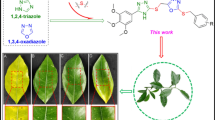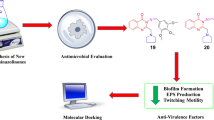Abstract
In this study, a series of N-functionalized benzimidazole silver(I) complexes were prepared and characterized by FT-IR, 1H, 13C{1H} NMR spectroscopy, and elemental analysis. Synthesized N-benzylbenzimidazole silver(I) complexes were evaluated for their antimicrobial activities against bacteria Escherichia coli, Pseudomonas aeruginosa, Staphylococcus aureus, and the fungal strains Candida albicans and Candida glabrata. The results indicated that N-alkylbenzimidazole silver(I) complexes exhibited good antimicrobial activity compared to N-alkylbenzimidazole derivatives. Especially, complex 2e presented perfect antimicrobial activity than the other complexes. The characterized molecules were optimized by DFT-based calculation methods and the optimized molecules were analyzed in detail by molecular docking methods against bacterial DNA-gyrase and CYP51. The amino acid residues detected for both target molecules are consistent with expectations, and the calculated binding affinities and inhibition constants are promising for further studies.
Graphical abstract
A series of N-alkylbenzimidazole silver(I) complexes were synthesized and fully characterized by means of 1H NMR, 13C NMR, and FT-IR spectroscopies. Synthesized N-alkylbenzimidazole silver(I) complexes were investigated for their antimicrobial activities against bacteria Escherichia coli, Pseudomonas aeruginosa, Staphylococcus aureus, and the fungal strains Candida albicans and Candida glabrata. All complexes showed better activity according to Ampicilin against Pseudomonas aeruginosa. The molecules which were firstly optimized by DFT-based calculation methods were also analyzed by molecular docking methods against DNA gyrase of E. Coli and CYP51. 338 × 190 mm (96 × 96 DPI)





Similar content being viewed by others
References
Goodman L, Gilman A, Hart N (1943) Preliminary investigations on the pharmacology of benzimidazole. Fed Proc 2:80
Woolley DW (1944) Some biological effects produced by benzimidazole and their reversal by purines. J Biol Chem 152(2):225–232
Bansal Y, Silakari O (2012) The therapeutic journey of benzimidazoles: a review. Bioorg Med Chem 20(21):6208–6236
López-Lira C, Tapia RA, Herrera A, Lapier M, Maya JD, Soto-Delgado J, Uriarte E (2021) New benzimidazolequinones as trypanosomicidal agents. Bioorg Chem 111:104823
Alzahrani HA, Alam MM, Elhenawy AA, Malebari AM, Nazreen S (2022) Synthesis, antiproliferative, docking and DFT studies of benzimidazole derivatives as EGFR inhibitors. J Mol Struct 1253:132265
Moreno-Herrera A, Cortez-Maya S, Bocanegra-Garcia V, Banik BK, Rivera G (2021) Recent advances in the development of broad-spectrum antiprotozoal agents. Curr Med Chem 28(3):583–606
Alasmary FA, Snelling AM, Zain ME, Alafeefy AM, Awaad AS, Karodia N (2015) Synthesis and evaluation of selected benzimidazole derivatives as potential antimicrobial agents. Molecules 20(8):15206–15223
Türkan F (2021) Investigation of the toxicological and inhibitory effects of some benzimidazole agents on acetylcholinesterase and butyrylcholinesterase enzymes. Arch Physiol Biochem 127(2):97–101
Gaba M, Singh S, Mohan C (2014) Benzimidazole: an emerging scaffold for analgesic and anti-inflammatory agents. Eur J Med Chem 76:494–505
Keri RS, Rajappa CK, Patil SA, Nagaraja BM (2016) Benzimidazole-core as an antimycobacterial agent. Pharmacol Rep 68(6):1254–1265
Sharma D, Narasimhan B, Kumar P, Judge V, Narang R, De Clercq E, Balzarini J (2009) Synthesis, antimicrobial and antiviral activity of substituted benzimidazoles. J Enzyme Inhib Med Chem 24(5):1161–1168
Xu JY, Zeng Y, Ran Q, Wei Z, Bi Y, He QH, Wu XM (2007) Synthesis and biological activity of 2-alkylbenzimidazoles bearing a N-phenylpyrrole moiety as novel angiotensin II AT1 receptor antagonists. Bioorganic Med Chem Lett 17(10):2921–2926
Maghraby MTE, Abou-Ghadir OM, Abdel-Moty SG, Ali AY, Salem OI (2020) Novel class of benzimidazole-thiazole hybrids: The privileged scaffolds of potent anti-inflammatory activity with dual inhibition of cyclooxygenase and 15-lipoxygenase enzymes. Bioorg Med Chem 28(7):115403
Veerasamy R, Roy A, Karunakaran R, Rajak H (2021) Structure–activity relationship analysis of benzimidazoles as emerging anti-inflammatory agents: An overview. Pharm 14(7):663
Şahin N, Çelebi MS, Ayvaz MÇ, Üstün E (2022) Antioxidant activity, enzyme inhibition, electrochemical and theoretical evaluation of novel PEPPSI type N-heterocyclic carbene complexes. Inorg Chem Commun 145:110028
Furst A, Schlauder MC (1978) Inactivity of two noble metals as carcinogens. J Environ Pathol Toxicol Oncol 1(1):51–57
Agency for Toxic Substances and Disease Registry (ATSDR) (1990) Toxicological profile for silver
Yushchishina A, Pasichnyk M, Mitryasova O, Koszelnik P, Gruca-Rokosz R, Kida M (2020) Research of aggregatic stability and bactericidal activities of nanosilver colloidal solutions. Rocz Ochr Srodowiska 22:40–50
Kascatan-Nebioglu A, Panzner MJ, Tessier CA, Cannon CL, Youngs WJ (2007) N-Heterocyclic carbene–silver complexes: A new class of antibiotics. Coord Chem Rev 251(5–6):884–895
Tomislav B, Franc P, Tomislav M, Ivana B (2020) Ligand influence on the formation of exo-coordinated silver (I) complexes with N2O2 Schiff base macrocycles and the role of anion in supramolecular aggregation. Polyhedron 190:114774
Hussaini SY, Haque RA, Razali MR (2019) Recent progress in silver(I)-, gold(I)/(III)- and palladium(II)-N-heterocyclic carbene complexes: a review towards biological perspectives. J Organomet Chem 882:96–111
Şahin N, Şahin-Bölükbaşı S, Marşan H (2019) Synthesis and antitumor activity of new silver (I)-N-heterocyclic carbene complexes. J Coord Chem 72(22–24):3602–3613
Üstün E, Şahin N, Çelik C, Tutar U, Özdemir N, Gürbüz N, Özdemir İ (2021) Synthesis, characterization, antimicrobial and antibiofilm activity, and molecular docking analysis of NHC precursors and their Ag-NHC complexes. Dalton Trans 50(42):15400–15412
Gohlke H, Klebe G (2002) Approaches to the description and prediction of the binding affinity of small-molecule ligands to macromolecular receptors. Angew Chem Int Ed 41(15):2644–2676
Şahin N, Üstün E, Tutar U, Çelik C, Gürbüz N, Özdemir İ (2021) Antimicrobial activity, inhibition of biofilm formation, and molecular docking study of novel Ag-NHC complexes. J Organomet Chem 954:122082
Ferreira LG, Dos Santos RN, Oliva G, Andricopulo AD (2015) Molecular docking and structure-based drug design strategies. Molecules 20(7):13384–13421
Saleh MA, Elmaaty AA, El Saeed HS, Saleh MM, Salah M, Eldin RRE (2022) Structure based design and synthesis of 3-(7-nitro-3-oxo-3, 4-dihydroquinoxalin-2-yl) propanehydrazide derivatives as novel bacterial DNA-gyrase inhibitors: In-vitro, In-vivo, In-silico and SAR studies. Bioorg Chem 129:106186
Lafitte D, Lamour V, Tsvetkov PO, Makarov AA, Klich M, Deprez P, Gilli R (2002) DNA gyrase interaction with coumarin-based inhibitors: the role of the hydroxybenzoate isopentenyl moiety and the 5‘-methyl group of the noviose. Biochem 41(23):7217–7223
Keniya MV, Sabherwal M, Wilson RK, Woods MA, Sagatova AA, Tyndall JD, Monk BC (2018) Crystal structures of full-length lanosterol 14α-demethylases of prominent fungal pathogens Candida albicans and Candida glabrata provide tools for antifungal discovery. Antimicrob Agents Chemother 62(11):e01134–e1218
Tyndall JD, Sabherwal M, Sagatova AA, Keniya MV, Negroni J, Wilson RK, Monk BC (2016) Structural and functional elucidation of yeast lanosterol 14α-demethylase in complex with agrochemical antifungals. PLoS One 11(12):e0167485
Üstün E, Ayvaz MC, Çelebi MS, Aşcı G, Demir S, Özdemir İ (2016) Structure, CO-releasing property, electrochemistry, DFT calculation, and antioxidant activity of benzimidazole derivative substituted [Mn(CO)3(bpy)L]PF6 type novel manganese complexes. Inorganica Chim Acta 450:182–189
Vlaović D, Čanadanović-Brunet J, Balaž J, Juranić I, Djoković D, Mackenzie K (1992) Synthesis, AntiBacteriol, and antifungal activities of some new benzimidazoles. Biosci Biotechnol Biochem 56(2):199–206
Üstün E, Düsünceli S, Özdemir İ (2017) [Mn (CO)(3)(bpy)(N-2-chlorobenzylbenzimidazole)] OTf complex as a new photoactivatable CO-releasing molecule. Bulg Chem Commun 49:50–56
Üstün E, Özgür A, Coşkun KA, Demir S, Özdemir İ, Tutar Y (2016) CO-releasing properties and anticancer activities of manganese complexes with imidazole/benzimidazole ligands. J Coord Chem 69(22):3384–3394
Yılmaz Ü, Tekin S, Buğday N, Yavuz K, Küçükbay H, Sandal S (2019) Synthesis and evaluation of anticancer properties of novel benzimidazole ligand and their cobalt (II) and zinc (II) complexes against cancer cell lines A-2780 and DU-145. Inorganica Chim Acta 495:118977
Arendrup MC, Meletiadis J, Mouton JW, Lagrou K, Hamal P, Guinea J (2020) EUCAST–Documento Definitivo E. DEF. 7.3. 2–Abril 2020.
Wayne PA (2018) 11th ed. CLSI standard M07.
Neese F (2012) The ORCA program system. Wiley Interdiscip Rev Comput Mol Sci 2(1):73–78
Neese F (2018) Software update: the ORCA program system, version 4.0. Wiley Interdiscip Rev Comput Mol Sci 8(1):e1327
Becke AD (1988) Density-functional exchange-energy approximation with correct asymptotic behavior. Phys Rev A 38(6):3098
Perdew JP (1986) Density-functional approximation for the correlation energy of the inhomogeneous electron gas. Phys Rev A 33(12):8822
Forli S, Huey R, Pique ME, Sanner MF, Goodsell DS, Olson AJ (2016) Computational protein–ligand docking and virtual drug screening with the AutoDock suite. Nat Protoc 11(5):905–919
Trott O, Olson AJ (2010) AutoDock Vina: Improving the speed and accuracy of docking with a new scoring function, efficient optimization, and multithreading. J Comput Chem 31(2):455–461
Morris GM, Goodsell DS, Halliday RS, Huey R, Hart WE, Belew RK, Olson AJ (1998) Automated docking using a Lamarckian genetic algorithm and an empirical binding free energy function. J Comput Chem 19(14):1639–1662
An CX, Han XL, Wang PB, Zhang ZH, Zhang HK, Fan ZJ (2008) Synthesis, crystal structures, and biological activities of silver(I) and cobalt(II) complexes with an azole derivative ligand. Transit Met Chem 33(7):835
Rauf A, Ye J, Hao A, Zhao L, Zhang S, Qi Y, Ning G (2018) An antibacterial silver(I) supramolecular network assembled from thiophene-2,5-dicarboxylate and benzimidazole. J Coord Chem 71(20):3266–3276
Karataş MO, Özdemir N, Sarıman M, Günal S, Ulukaya E, Özdemir İ (2021) Water-soluble silver(i) complexes with N-donor benzimidazole ligands containing an imidazolium core: stability and preliminary biological studies. Dalton Trans 50(33):11596–11603
Knapp AR, Panzner MJ, Medvetz DA, Wright BD, Tessier CA, Youngs WJ (2010) Synthesis and antimicrobial studies of silver N-heterocyclic carbene complexes bearing a methyl benzoate substituent. Inorg Chim Acta 364(1):125–131
Zhang S, Du C, Wang Z, Han X, Zhang K, Liu L (2013) Reduced cytotoxicity of silver ions to mammalian cells at high concentration due to the formation of silver chloride. In Vitro Toxicol 27(2):739–744
Jimenez J, Chakraborty I, Del Cid AM, Mascharak PK (2017) Five- and six-coordinated silver(I) complexes derived from 2,6-(Pyridyl)iminodiadamantanes: sustained release of bioactive silver toward bacterial eradication. Inorg Chem 56(9):4784–4787
Tuffery P, Derreumaux P (2012) Flexibility and binding affinity in protein–ligand, protein–protein and multi-component protein interactions: limitations of current computational approaches. J R Soc Interface 9(66):20–33
Abdolmaleki B, Maddah M (2022) Screening of indole derivatives as the potent anticancer agents on dihydrofolate reductase: pharmaco-informatics and molecular dynamics simulation. J Biomol Struct Dyn 41(8):3667–3679
Sanyal G, Doig P (2012) Bacterial DNA replication enzymes as targets for antibacterial drug discovery. Expert Opin Drug Discov 7(4):327–339
Bates AD, Maxwell A (2007) Energy coupling in type II topoisomerases: why do they hydrolyze ATP. Biochem 46(27):7929–7941
Anastasiadou D, Geromichalou E, Tsavea E, Psomas G, Hatzidimitriou AG, Kalogiannis S, Aslanidis P (2020) Silver complexes with heterocyclic thioamide and tertiary arylphosphane ligands: Synthesis, crystal structures, in vitro and in silico antibacterial and cytotoxic activity, and interaction with DNA. J Inorg Biochem 210:111167
Gudimani P, Hebbar NU, Shastri SL, Shastri LA, Shettar AK, Hoskeri JH, Sunagar VA (2023) A new approach for the synthesis of tri-substituted pyrazole propionic acids derivatives: Anti-inflammatory, antimicrobial and molecular docking studies. J Mol Struct 1285:135405
Türker D, Üstün E, Günal S, Yıldız H, Düşünceli DS, Özdemir İ (2022) Cyanopropyl functionalized benzimidazolium salts and their silver N‐heterocyclic carbene complexes: synthesis, antimicrobial activity, and theoretical analysis. Arch Pharm 355(6):2200041
Janakiramudu DB, Subba Rao D, Srikanth C, Madhusudhana S, Sreenivasa Murthy P, Nagalakshmidevamma M, Naga Raju C (2018) Sulfonamides and carbamates of 3-fluoro-4-morpholinoaniline (linezolid intermediate): synthesis, antimicrobial activity and molecular docking study. Res Chem Intermed 44:469–489
Sadeghian S, Emami L, Mojaddami A, Faghih Z, Zomorodian K, Rashidi M, Rezaei Z (2023) 1, 2, 4-Triazole derivatives as novel and potent antifungal agents: Design, synthesis and biological evaluation. J Mol Struct 1271:134039
Monk BC, Sagatova AA, Hosseini P, Ruma YN, Wilson RK, Keniya MV (2020) Fungal Lanosterol 14α-demethylase: A target for next-generation antifungal design. Biochim Biophys Acta Proteins Proteom 1868(3):140206
Souza RA, Cunha VL, de Souza JH, Martins CH, Franca EDF, Pivatto M, Oliveira CG (2022) Zinc (II) complexes bearing N, N, S ligands: Synthesis, crystal structure, spectroscopic analysis, molecular docking and biological investigations about its antifungal activity. J Inorg Biochem 237:111995
Golbaghi G, Groleau MC, Lopez de los Santos Y, Doucet N, Déziel E, Castonguay A (2020) Cationic Ru II cyclopentadienyl complexes with antifungal activity against several candida species. ChemBioChem 21(21): 3112–3119
Acknowledgements
This work was financially supported by the İnönü University Research Fund (FBG-2021-2562).
Funding
The funding has been received from İnönü University Research Fund with Grant no. FBG-2021-2562.
Author information
Authors and Affiliations
Corresponding author
Ethics declarations
Conflict of interest
The authors have no conflicts of interests to declare.
Additional information
Publisher's Note
Springer Nature remains neutral with regard to jurisdictional claims in published maps and institutional affiliations.
Supplementary Information
Below is the link to the electronic supplementary material.
Rights and permissions
Springer Nature or its licensor (e.g. a society or other partner) holds exclusive rights to this article under a publishing agreement with the author(s) or other rightsholder(s); author self-archiving of the accepted manuscript version of this article is solely governed by the terms of such publishing agreement and applicable law.
About this article
Cite this article
Arı, E., Şahin, N., Üstün, E. et al. Synthesis, antimicrobial activity and molecular docking study of benzyl functionalized benzimidazole silver(I) complexes. J Biol Inorg Chem 28, 725–736 (2023). https://doi.org/10.1007/s00775-023-02024-y
Received:
Accepted:
Published:
Issue Date:
DOI: https://doi.org/10.1007/s00775-023-02024-y




